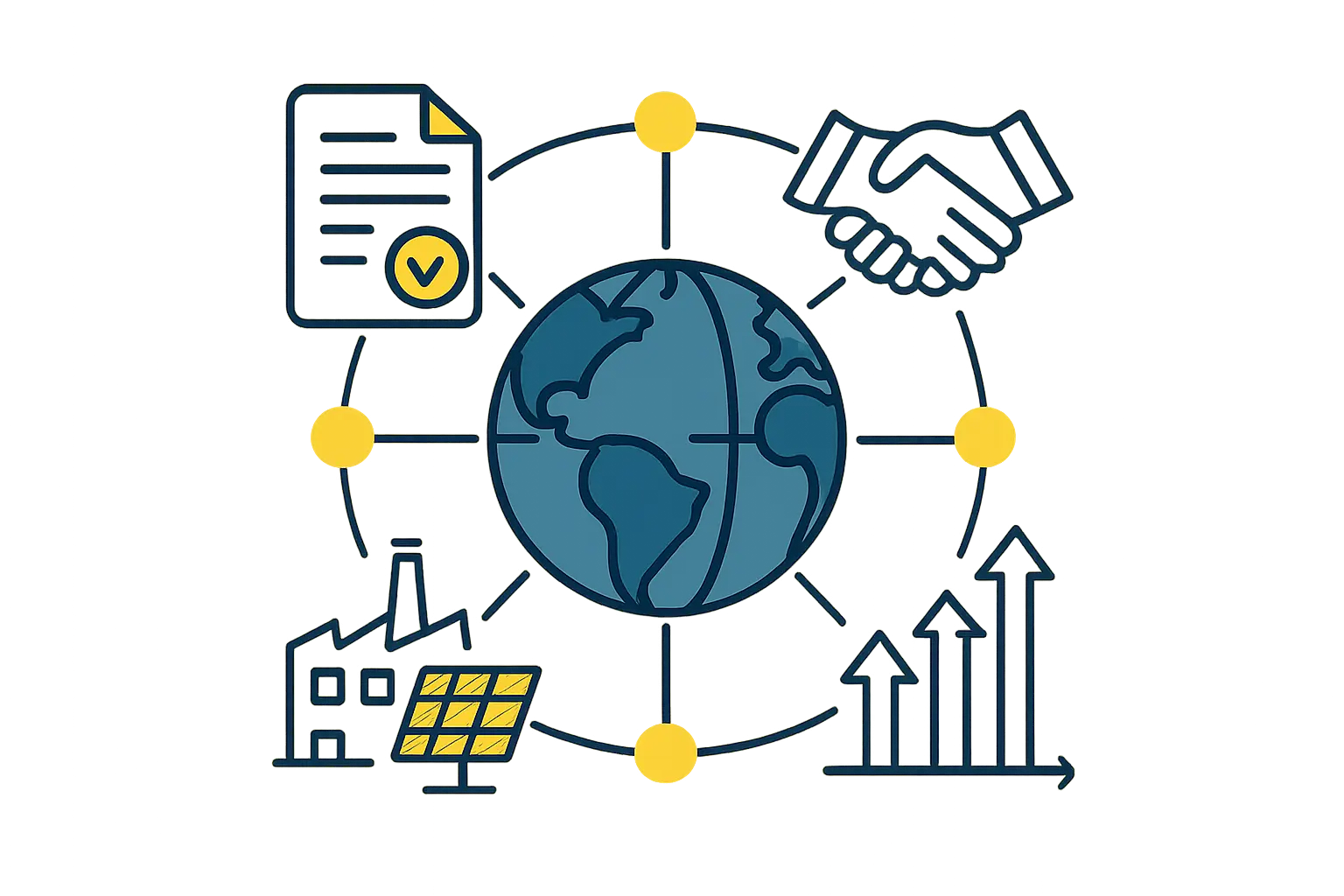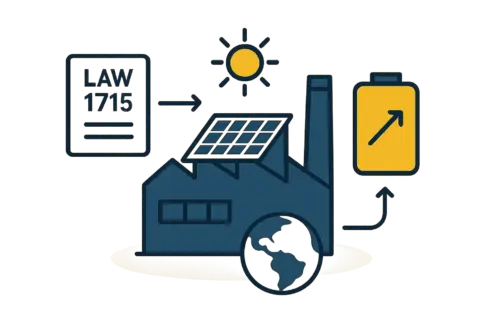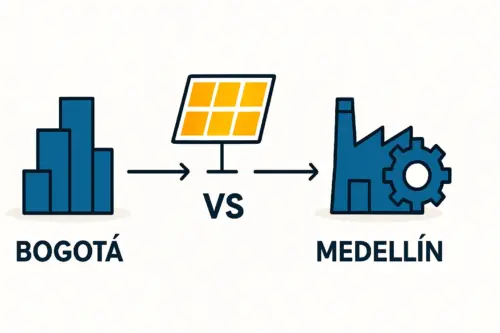An entrepreneur entering Colombia’s growing solar market often focuses on the big picture: factory setup, machinery, and market demand. Before long, however, a crucial question emerges that can define the entire business case: “Where will the raw materials come from?”
The decision between sourcing components locally and relying on international imports is one of the most strategic choices a new solar panel manufacturer will make. This analysis offers a practical look at the feasibility of both approaches within the Colombian context. We’ll examine which components can realistically be sourced locally and which are better imported, providing a framework for building a resilient and cost-effective supply chain.
Table of Contents
The Strategic Importance of Your Supply Chain
The choice of suppliers is more than a line item in a budget—it directly impacts production timelines, final product quality, and logistical complexity. A well-planned supply chain minimizes risk, whereas a poorly considered one can lead to costly delays and quality issues. Sourcing decisions are a fundamental part of calculating the total cost to start a solar panel factory and must be addressed in the earliest stages of business planning.
Driven by government incentives like Law 1715 (2014) and Law 2099 (2021), Colombia has fostered a favorable environment for renewable energy projects. These regulations offer tangible benefits, including income tax deductions and exemptions from VAT and import tariffs for equipment and materials. This framework makes both local production and strategic importation financially viable paths to explore.
Assessing Local Sourcing Potential in Colombia
For a new manufacturing venture, leveraging a country’s existing industrial capacity can provide a significant competitive advantage. Colombia has established industries that offer potential synergies for solar component manufacturing.
Aluminum Frames: The Strongest Case for Localization
The aluminum frame is a critical structural component that protects the laminate and provides the means for mounting the solar panel. It is also one of the bulkiest and heaviest parts of a module.
Colombia has a well-developed aluminum extrusion industry, with established companies capable of producing complex profiles. This makes it a clear opportunity for localization.
Benefits: Sourcing frames locally can drastically reduce shipping costs and exposure to international freight volatility. It also allows for shorter lead times and more agile inventory management.
Challenges: The primary challenge is technical. Solar panel frames require high-precision manufacturing and specific anodization thicknesses to withstand decades of outdoor exposure. A local supplier must be able to meet these stringent quality standards consistently. Vetting and co-developing the product with a local partner is essential.
Solar Glass: A Feasible but Capital-Intensive Opportunity
The front glass of a solar panel is a highly specialized product. It must be low-iron for maximum light transmission, fully tempered for strength, and often features an anti-reflective coating.
Ready to make big Profits?
The solar Industry is Booming
WE HELP NEWCOMERS to the solar industry start their own solar module production line. Customers can make BIG PROFITS by selling modules and finding investors, without wasting money and time on things they don't need!
While Colombia has major glass manufacturers, producing solar-grade glass requires a dedicated production line—a significant capital investment. An existing manufacturer would need a strong business case to justify modifying or building a facility for this purpose. For a new solar factory, this is more of a long-term possibility than an immediate solution.
Junction Boxes and Packaging: Exploring the Ancillaries
Junction Boxes: These enclosures protect the electrical connections on the back of the panel. Colombia’s plastics and electronics industries could potentially produce them, but the technical requirements are demanding. Junction boxes must have high IP ratings (e.g., IP67 or IP68) to protect against water and dust ingress and be made from UV-stable materials certified for high-voltage DC applications. The risk of sourcing a non-compliant component is substantial.
Packaging: Materials like cardboard boxes, corner protectors, and strapping are excellent candidates for local sourcing. They are low-tech, and procuring them locally can offer significant cost savings and logistical simplicity.
The Reality of Imports: Essential High-Tech Components
Despite the potential for local sourcing, certain core components of a solar panel are the products of a highly specialized, capital-intensive global supply chain. For any new manufacturer in Colombia, importing these is a practical necessity.
Solar Cells and Silicon Wafers: The Heart of the Module
The solar cell is the semiconductor device that converts sunlight into electricity. Its manufacturing involves complex processes, from growing silicon ingots to wafering, doping, and coating. This industry is dominated by a handful of major international players and requires billions of dollars in investment to establish.
This means solar cells will remain an imported component for the foreseeable future. A key part of the solar panel manufacturing process involves carefully assembling these imported cells into strings.

Encapsulants (EVA) and Backsheets: Specialized Polymers
Ethylene Vinyl Acetate (EVA) is the adhesive film used to laminate the layers of the panel, while the backsheet provides electrical insulation and mechanical protection. Both are specialized polymer products manufactured in large chemical facilities. The market is concentrated among a few global suppliers, making importation the only practical option.
A Practical Framework: Balancing Cost, Quality, and Logistics
The most effective strategy for a new Colombian solar panel manufacturer is a hybrid model that balances the benefits of local sourcing with the realities of the global market.
The Hybrid Model: A Recommended Starting Point
A pragmatic approach involves focusing localization efforts where they provide the most immediate impact:
- Import Core Components: Source high-tech, critical items like solar cells, EVA, and backsheets from reputable international suppliers.
- Localize Bulky Components: Actively pursue partnerships with local companies for aluminum frames and all packaging materials.
This strategy mitigates technical risk while capturing significant logistical cost savings. As the operation scales, further localization of components like junction boxes or even glass can be explored.

Navigating Import Logistics and Quality Control
When importing materials, logistical efficiency is key. Colombia’s major ports in Cartagena and Buenaventura are well-equipped to handle international freight, but inland transportation costs and timelines must be factored into the overall business plan.
Crucially, a robust system for solar panel quality control must begin with incoming materials. Experience in turnkey projects shows that establishing strict inspection protocols for all imported goods is non-negotiable. Identifying a defect upon arrival is far more cost-effective than discovering it after a component has been integrated into a finished product.
Leveraging Colombia’s Incentives
The government’s supportive policies are designed to ease the financial burden of establishing a new energy enterprise. The VAT and tariff exemptions under Law 2099 apply directly to imported raw materials and machinery for a turnkey solar panel production line, strengthening the business case for the hybrid import-local model.
Frequently Asked Questions (FAQ)
Q: Which component offers the best starting point for local sourcing?
A: Aluminum frames are the most logical place to start. They are bulky, expensive to ship, and Colombia has an existing industrial base capable of producing them, provided the technical specifications can be met.
Q: Do I need a technical background to manage this supply chain?
A: While a technical background is helpful, it isn’t a prerequisite. What’s essential is a structured approach to supplier vetting and quality control, often guided by an experienced technical partner. The goal is to establish clear specifications and verification processes, not to be an expert in every material.
Q: How do import tariffs affect the business plan?
A: Under current legislation (Law 2099), equipment, materials, and machinery for renewable energy production are generally exempt from VAT and customs tariffs. This significantly reduces the cost of imported components and is a critical factor in the financial viability of a new manufacturing plant.
Q: Can a turnkey solar panel production line be adapted for locally sourced materials?
A: Yes, a modern production line is designed for flexibility. However, the specifications of all raw materials—whether imported or locally sourced—must be clearly defined during the factory planning phase. This ensures that machinery, such as framing stations, is calibrated correctly for the specific components being used.
Conclusion: Building a Resilient Colombian Solar Supply Chain
Entering the solar manufacturing sector in Colombia is a promising venture, backed by strong government support and growing market demand. Success, however, depends on building a smart and resilient supply chain.
A hybrid strategy that leverages Colombia’s industrial strengths for bulky components while relying on established global suppliers for high-tech materials offers the most balanced, lowest-risk path forward. By carefully planning this foundational aspect of the business, an entrepreneur can create a competitive and sustainable operation poised to contribute to Colombia’s clean energy future.






